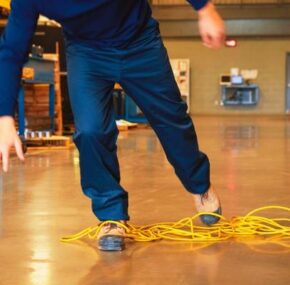Recently, the Occupational Safety and Health Administration (OSHA) withdrew its “Slips, Trips and Falls rule” from the White House review process- a move that will leave employers on shaky ground in the coming months. The rule was withdrawn so that OSHA could review its costs and benefits, but in doing so, they left many employers unsure about how to proceed.

OSHA is in charge of establishing rules, regulations and safety standards that employers are required to comply with in order to ensure that American workers are provided with a safe working environment. Additionally, the regulations set forth by OSHA can help protect employers who are in compliance with the rules avoid liability for injuries that may be sustained.
The Slips, Trips and Falls Rule
Slips, trips and falls are responsible for approximately 3,500 serious injuries, 20 fatalities, and billions of dollars in workers compensation payments every year. The rule, which was established in 1990, created requirements for personal fall protection equipment, guard rails, and regulations for working/ walking surfaces in the workplace. OSHA has stated that the withdrawal of the rule is likely to only be temporary. They plan to review and finalize the rule during the current term and then re-publish it once that has been accomplished.
Impact on Employers
In a way, some employers have taken advantage of the fact the the rule was proposed, because in some cases, they were not able to receive penalties in the event of a minor citation due to so many grey areas. Guardrail height regulation was just one of the grey areas in the proposed rule. The standard for guardrails was set at 42 inches. Guardrails that reached a height of 36 inches, however, were considered to be a de minimis violation that was without penalty. By withdrawing the rule and reanalyzing it, there is a chance that new OSHA guidelines will eliminate the previous de minimis violation treatment that employers were receiving.
Impact on Workplace Safety
With the Slips, Trips, and Falls rule being virtually nonexistent at this time, many employers are unsure about how to proceed in order to ensure workplace safety. New facilities, and those that are expanding or being remodeled may face difficult challenges in the months, or even years, to come. Unfortunately, such unsurety is certain to impact the safety of workers in these facilities. With no protocol for employers to follow, workers are more likely than ever to experience slips, trips and falls that result in injuries due to unsafe walkways/ work areas, inadequate guardrails, and inappropriate fall protection.
Working Together to Prevent Slips, Trips and Falls
With the OSHA regulations out the window for now, it is vital that employers and employees work together to help reduce the risk of slips, trips and falls in the workplace. According to the National Safety Council (NSC), the risk of injuries sustained from slips, trips and falls can be prevented, or at least reduced by following these tips:
- Clean up spills as soon as they are noticed and place wet floor signs as necessary.
- Place rugs or textured walk surfaces in front of entryways to prevent snow, ice and water from being tracked inside.
- Keep walkways clear of debris, electrical cords and other items.
- Use non-skid mats under throw rugs to keep them from slipping.
- Wear shoes with slip-resistant soles.
- Install handrails on stairways and guardrails around elevated spaces.
Slip, Trip and Fall Injuries in the Workplace
While slips, trips and falls are not a major cause of fatalities in the workplace, they are one of the most common causes of injuries that result in missed days from work. Although some injuries incurred during a slip, trip or fall are very minor, others are so severe that they leave the victim unable to return to work, either temporarily or permanently. Some incidents result in head injuries, fractured bones, torn muscles, and cuts or bruises that require ongoing medical treatment which can become expensive very quickly.
Some slips, trips and falls in the workplace are purely accidental and occur through no fault of anyone. In these cases, victims can file a workers compensation claim and could receive monetary reimbursement for things like lost current wages, lost future wages and medical expenses. In other situations, these types of accidents are caused through the direct actions or negligence of a third party. A fall from a faulty ladder is a good example of an accident that is caused by a third party. When injuries are incurred in the workplace due to the negligence or intentional actions of a third party, the victim may be eligible to file a personal injury lawsuit or a product liability lawsuit in addition to receiving workers compensation benefits.







